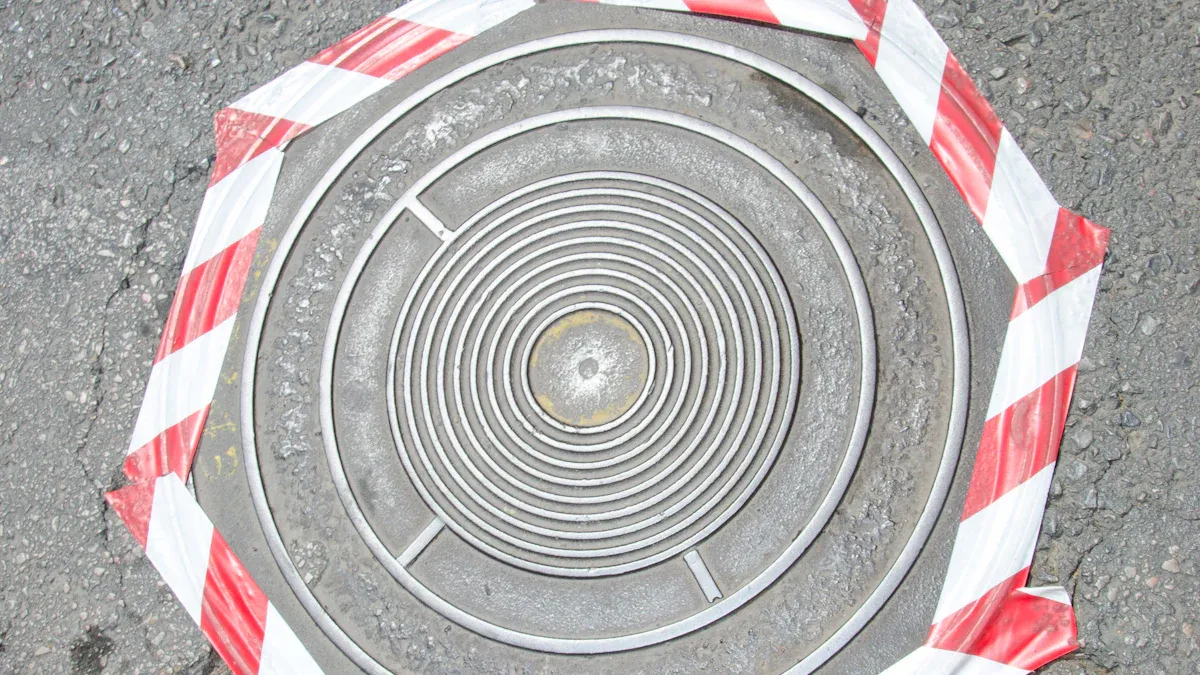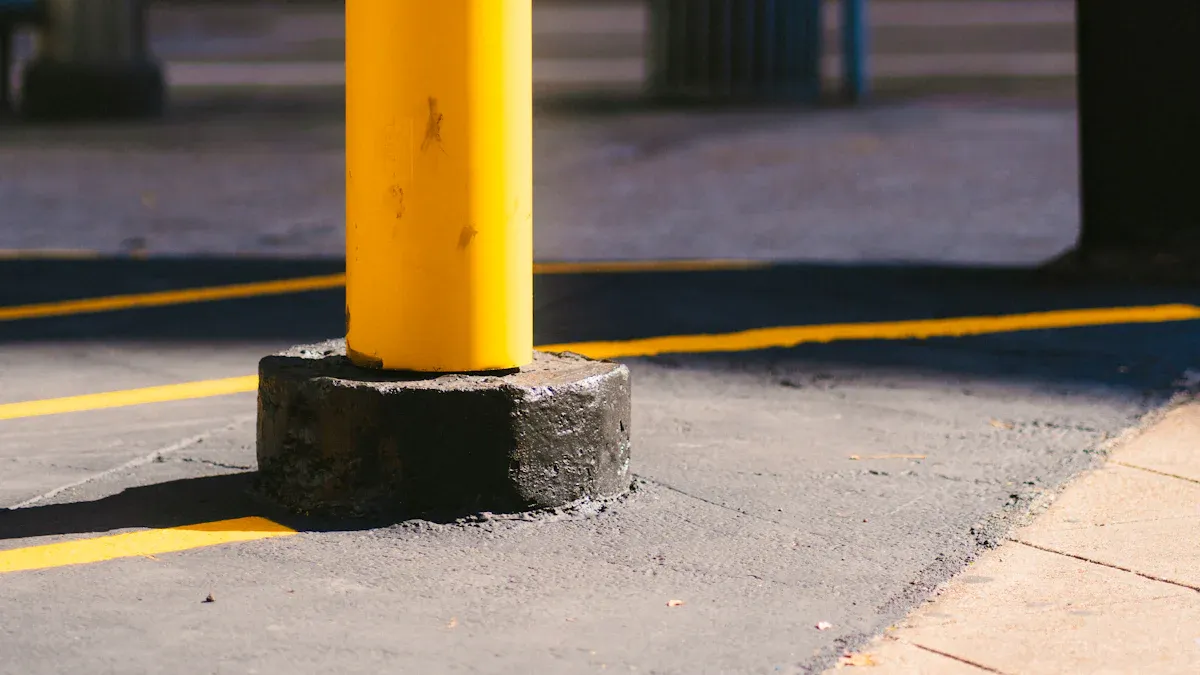
Proper maintenance of Pvc Lane Marking Tape ensures clear, durable lines and prevents premature wear. Facility managers monitor tape condition to minimize hazards and maintain a professional appearance.
Regular removal and replacement protect floor surfaces, reducing costly repairs and supporting workplace safety.
Key Takeaways
- Keep PVC lane marking tape clean by sweeping regularly and mopping with mild detergent to maintain visibility and extend its life.
- Inspect tape often for wear or damage and fix small problems quickly to prevent accidents and keep markings clear.
- Remove tape carefully using the right tools and gentle methods to protect floors and make future replacements easier.
PVC Lane Marking Tape: Essential Facts
Key Features of PVC Lane Marking Tape
PVC lane marking tape offers a combination of durability, flexibility, and visibility. Manufacturers design this tape to resist abrasion, moisture, and many chemicals. The tape adheres securely to a variety of surfaces, including concrete and tile, which makes it suitable for both temporary and permanent applications. Its bright colors and clear lines help improve visibility in busy environments. Many products feature easy-to-remove adhesives, which allow for quick changes without damaging the underlying surface. The tape’s thickness and construction enable it to withstand moderate traffic, including foot traffic and light machinery. Users often select this tape for its cost-effectiveness and ease of installation compared to painted lines.
Common Applications
Pvc Lane Marking Tape finds widespread use in environments that demand clear, durable markings.
Facility managers rely on this tape to organize spaces and enhance safety.
- Warehouses and industrial manufacturing facilities use the tape to mark aisles, zones, and safety areas.
- The tape designates aisleways, traffic lanes, and production equipment locations.
- Many facilities use it to highlight defect areas, inspection zones, and storage for finished goods or raw materials.
- The tape withstands modest forklift traffic, pallets, and exposure to chemicals or spills.
- Areas with physical or health risks often feature this tape to alert workers and visitors.
This versatility supports its popularity in dynamic, high-traffic settings.
Maintenance of PVC Lane Marking Tape

Cleaning Methods and Frequency
Routine cleaning extends the life of lane markings and preserves their visibility. Facility staff should sweep or vacuum the tape regularly to remove dust, debris, and grit. Wet mopping with a mild, non-abrasive detergent helps maintain the tape’s color and adhesive strength. Avoid harsh chemicals or abrasive pads, as these can degrade the tape surface or weaken the adhesive.
Tip: Schedule cleaning after peak hours to minimize disruption and allow the tape to dry completely before resuming traffic.
For high-traffic areas, increase cleaning frequency to prevent buildup that can obscure markings. In low-traffic zones, weekly cleaning often suffices. Always check manufacturer recommendations for compatible cleaning agents and methods.
Inspection and Early Repairs
Regular inspections ensure that Pvc Lane Marking Tape remains effective and safe. Facility managers should walk the marked areas and look for signs of wear, fading, or peeling.
- Select durable, high-quality adhesive tapes that match the facility’s traffic and environmental conditions.
- Conduct periodic inspections to confirm that all markings remain visible and intact.
- Replace any tape that appears faded, damaged, or worn out.
- Update markings when facility layouts or traffic patterns change.
- Train employees on the importance of floor markings and encourage them to report issues.
Early repairs prevent minor damage from spreading. When staff notice small sections lifting or peeling, they should press them down or replace the affected area promptly. This proactive approach reduces the risk of accidents and maintains a professional appearance.
Preventing Common Maintenance Issues
Preventative measures help avoid common problems with lane marking tape. Staff should ensure that the floor surface is clean and dry before applying new tape. Moisture, oil, or dust can weaken the adhesive and cause premature lifting.
Note: Proper surface preparation is the most effective way to prevent tape failure.
Limit exposure to harsh chemicals and heavy machinery in marked areas. Place protective mats or barriers in locations where tape faces frequent impact or chemical spills. Rotate cleaning and inspection duties among staff to ensure consistent maintenance standards.
A well-maintained marking system supports safety, efficiency, and compliance in any facility.
Step-by-Step Removal of PVC Lane Marking Tape

Preparation and Safety Measures
Proper preparation ensures a smooth and safe removal process. Facility staff should begin by clearing the area of obstacles and notifying workers about the removal activity. They must wear gloves to protect their hands from adhesive and sharp tools. Safety goggles shield eyes from debris. Staff should check the floor for spills or moisture before starting. Dry surfaces prevent slips and help the tape come off cleanly.
Tip: Always ventilate the area if using chemical adhesive removers. Good airflow reduces inhalation risks.
Tools and Materials Needed
Selecting the right tools makes removal efficient and protects the floor. The following table lists common tools and their uses:
| Tool/Material | Purpose |
|---|---|
| Utility knife | Cutting and lifting tape edges |
| Plastic scraper | Peeling tape without scratching surfaces |
| Heat gun or hair dryer | Softening adhesive for easier removal |
| Adhesive remover | Dissolving stubborn residue |
| Clean rags | Wiping surfaces after removal |
| Gloves and goggles | Personal protection |
Staff should gather all materials before starting. This preparation prevents delays and reduces the risk of damaging the floor.
Removal Techniques for Different Surfaces
Different surfaces require specific removal methods. On smooth concrete or tile, staff can lift one edge of the tape with a utility knife. They should pull the tape back slowly at a low angle. This technique reduces adhesive left behind. For older or brittle tape, a heat gun or hair dryer helps soften the adhesive. Staff should move the heat source back and forth to avoid overheating one spot.
On painted or sensitive floors, a plastic scraper works best. Staff should avoid metal tools, which can scratch or gouge the surface. For textured floors, they may need to use more heat and gentle scraping. Patience prevents damage and ensures a clean result.
Note: Test removal methods on a small, hidden area first. This step confirms that the technique will not harm the floor.
Cleaning Adhesive Residue
After removing the tape, some adhesive may remain. Staff should apply a commercial adhesive remover or a solution recommended by the tape manufacturer. They should let the remover sit for a few minutes to soften the residue. Using a clean rag, they can wipe away the softened adhesive. For stubborn spots, a plastic scraper helps lift residue without scratching.
Staff should finish by cleaning the area with mild detergent and water. This step removes any leftover chemicals and prepares the surface for new markings if needed.
Callout: Never use harsh solvents or abrasive pads. These products can damage the floor and reduce its lifespan.
Troubleshooting PVC Lane Marking Tape Removal
Handling Stubborn Adhesive
Stubborn adhesive often remains after removing Pvc Lane Marking Tape. Several factors contribute to this challenge:
- The type of tape and adhesive used can affect residue levels. Strong-adhesive tapes, such as reflective or safety tapes, tend to leave more residue.
- Adhesive composition and its interaction with the floor surface play a significant role.
- Longer application times allow adhesive to harden, making removal more difficult.
- Improper removal techniques or unsuitable solvents can worsen the problem.
- Surface material compatibility with removal methods matters. For example, acetone may soften adhesive but damage acrylic floors.
To address stubborn adhesive, staff should start with a gentle adhesive remover and a plastic scraper. Allow the remover to sit for several minutes before wiping. If residue persists, repeat the process or try a different remover recommended by the tape manufacturer.
Tip: Always test any chemical remover on a small, hidden area to ensure it does not harm the floor.
Avoiding Surface Damage
Protecting the floor during tape removal is essential. Staff should avoid metal tools, which can scratch or gouge surfaces. Plastic scrapers and soft cloths provide safer alternatives. When using heat, keep the device moving to prevent overheating one spot. Select adhesive removers that match the floor material. For sensitive surfaces, choose products labeled as safe for that specific type.
Routine inspection during removal helps spot early signs of damage. If discoloration or scratches appear, stop and reassess the method. Proper technique preserves both the appearance and integrity of the facility’s floors.
Tips for Long-Lasting PVC Lane Marking Tape
Selecting Quality Tape
Choosing the right tape ensures durability and safety in industrial and commercial environments. High-quality lane marking tapes feature strong adhesive properties, resistance to wear, and the ability to withstand harsh conditions. Manufacturers continue to improve materials and adhesives, resulting in products that last longer and perform better. Facility managers should look for tapes that meet recognized industry certifications and standards. The following table highlights important certifications:
| Certification/Standard | Description | Relevance to Lane Marking Tape |
|---|---|---|
| ISO 9001 | Quality management system certification | Ensures consistent product quality |
| UL 6 | Safety standard for PVC coatings | Validates safety and adhesion |
| ETL PVC-001 | Performance certification for PVC coatings | Confirms durability and adhesion |
| NEMA RN-1 | Standard for continuous PVC coatings | Ensures abrasion resistance |
| IEC IP69 / UL Type 4X | Ingress protection rating | Guarantees environmental protection |
Tip: Tapes like 3M Vinyl Tape 471 offer high abrasion resistance and comply with OSHA and ANSI safety standards.
Proper Application for Easy Maintenance and Removal
Proper installation extends the life of lane marking tape and simplifies future removal. Facility staff should always apply tape to clean, dry surfaces. They must press the tape firmly to ensure full contact and prevent lifting. Using a roller can help achieve even adhesion. Staff should avoid stretching the tape during application, as this can cause it to shrink or peel over time.
- Clean and dry the floor before application.
- Use a roller for firm, even adhesion.
- Avoid stretching the tape.
- Follow manufacturer guidelines for best results.
Routine inspections and prompt repairs also help maintain clear, safe markings. These steps support compliance with safety regulations and reduce long-term maintenance costs.
Facility managers achieve optimal results by following key steps: regular cleaning, prompt repairs, and careful removal. Durable tapes withstand harsh environments, resist chemicals, and maintain visibility in low-light conditions. Color-coded and reflective options enhance safety. Adhering to best practices ensures compliance, reduces risks, and supports a productive workplace.
FAQ
How often should facility staff inspect PVC lane marking tape?
Facility staff should inspect tape weekly in high-traffic areas. Regular checks help identify wear, peeling, or fading before safety becomes compromised.
What is the best way to remove stubborn adhesive residue?
Apply a manufacturer-recommended adhesive remover. Allow it to sit for several minutes. Use a plastic scraper or clean rag to wipe away softened residue.
Can PVC lane marking tape be used outdoors?
Manufacturers design most PVC lane marking tapes for indoor use. For outdoor applications, select tapes labeled as UV-resistant and weatherproof.
Post time: Jul-14-2025




